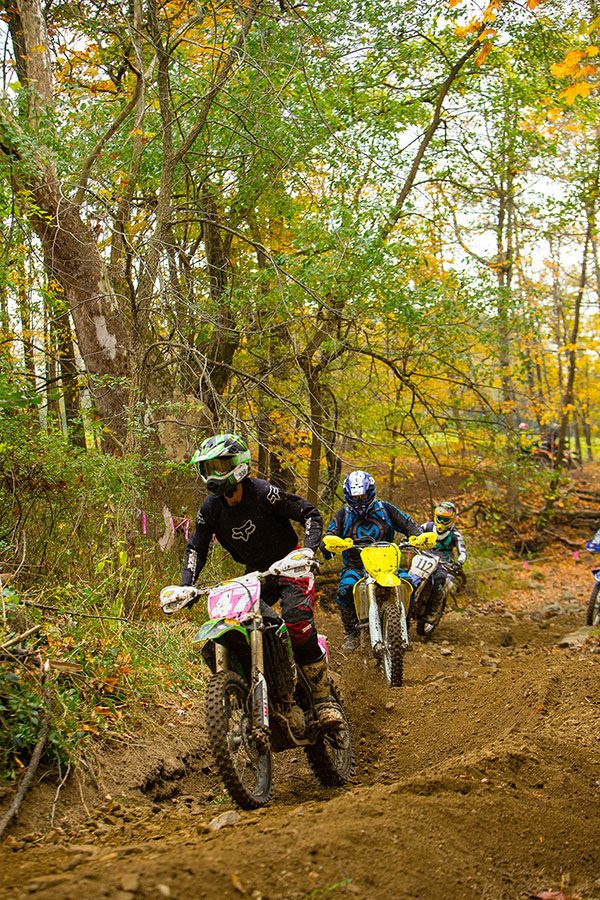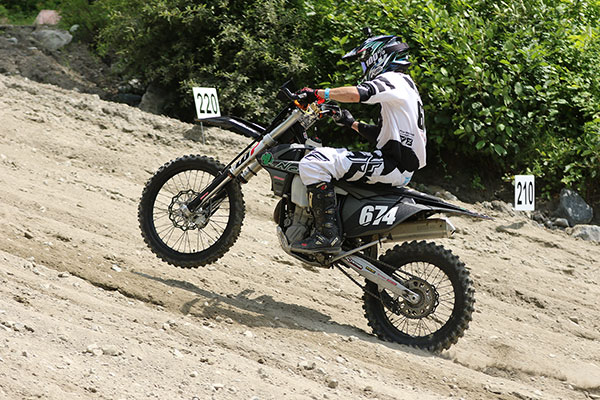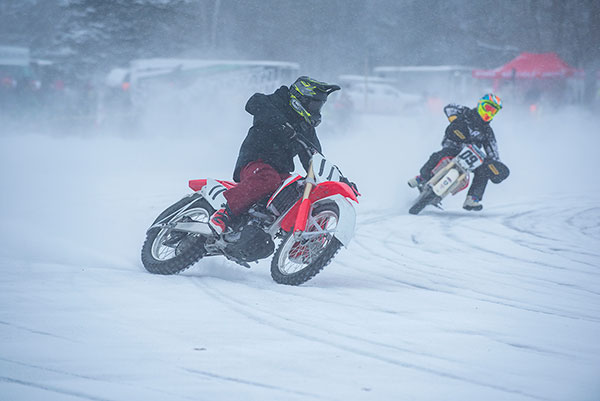AMERICAN MOTORCYCLIST DECEMBER 2018
One motorcycle, many ways to race it
Motocross Bikes Can Get You Racing In New Ways

Motocross bikes compete in closed-course off-road races with few modifications.
Bike choice on the showroom floor rises and falls as market forces change.
The 1970s may have been the high water mark for model specialization, with several companies offering multiple options ranging from motocross to off-road to trail bike to dual-sport with either two- or four-stroke engines.
Today, only Austrian company KTM comes close to offering the breadth of two- and four-stroke options available four decades ago, although Japanese manufacturer Yamaha isn’t far behind.
But since they exploded in popularity in the early 1970s, motocross bikes have always been prevalent. Today, they are among the most popular among racers, and not just motocrossers.
This is because with a few adjustments and alterations, a standard MX machine can compete in numerous disciplines.
Although factories sell more specialized models, motocross bikes fall into cross-discipline service for a variety of reasons:
Personalization. Motocross bikes are relatively stripped down, and some riders prefer to start with a clean slate when building their race bikes.
Cost. In some cases, motocross bikes are cheaper than manufacturer’s more specialized models—although costs ramp up quickly as you add aftermarket parts.
You race what you have. It’s unrealistic to buy a new bike every time you want to try a new discipline.
There are limits on what you can do within the rules of competition. For specific class restrictions, including engines sizes and allowed modifications, see the AMA Racing Amateur Rulebook at www.americanmotorcyclist.com.
Here is a general overview of some types of off-road and track racing events in which you can compete and how motocross models are modified for non-motocross events.
Off-Road
Almost all major manufacturers offer off-road versions of their motocross models. If you are starting from scratch and you are racing off-road exclusively, it will be easier, and often cheaper, to begin with a factory off-road bike.
In addition, in some states, environmental regulations may require you to compete on an off-road model, which will have emission controls that the motocross models will lack. Depending on the event, you may also need a factory street legal dual-sport bike.
But if you live in a state, and are competing in an event, where it’s legal to do so, with a few modifications, you can race the motocross bike in your garage.
One of the most beneficial modifications is softening up the suspension for off-road racing. While a professional revalve will be the most effective solution, let the technician doing the work know if you intend to continue racing motocross. For a less permanent fix, simply explore the adjustments available on your stock suspension and explained in your owner’s manual.
Racers also may want to change their motorcycle’s gearing, depending on which off-road discipline they decide to try: taller gearing (smaller rear sprocket or larger front sprocket) for higher speeds and less-abrupt power transfer to the rear wheel, or shorter gearing (larger rear sprocket or smaller front sprocket) for slower speeds and more torque.
Tire selection is one of the most important decisions you will make. What works well on a hard-packed motocross track likely won’t be the best choice for an off-road course, which could call for a mud tire, a sand tire, a tire that will resist chunking on rocks or even a trials tire.
One of the more popular modifications is to replace the stock 19-inch rear wheel that motocross models come with an 18-inch rear wheel, which allows more off-road-friendly tire options. This is why all full-sized off-road models come with 18-inch wheels from the factories.
Enduro
Enduros feature challenging routes on a wide range of terrain, primarily through the woods. They include individual test sections that are connected with roads or relatively easy trail. Total length may top 100 miles of riding.
Enduros are raced against the clock. Riders are released into test areas in small groups that may or may not include riders in the same class. Each rider is timed through the test sections to determine finishing position.
Several modifications are common to make a motocross bike more durable and competitive for an enduro. Examples include a skid plate, suspension work, an aftermarket exhaust and exhaust guard, a larger fuel tank, radiator guards, heavy-duty tire tubes that resist flats and a cable connecting the end of the rear brake pedal to the frame to keep the pedal from being bent or broken.
Handguards are recommended for protecting against trees, roost from other riders and crashes.
It’s important to have a route sheet holder. The route sheet includes information about turns, time and mileage. A holder makes it easy to view and advance the route sheet as you ride.
For traditional time-keeping enduros that penalize racers for completing certain test sections too quickly, racers need to develop timekeeping skills to make sure they hit checkpoints on time. While sophisticated timekeeping devices are available, the task also can be accomplished using an odometer, a watch and information on the route sheet.
Restart enduros don’t penalize riders for arriving at a check early, so timekeeping equipment isn’t necessary. Restart enduros do require riders to begin a test at a specific time, however, so a watch and a route sheet holder are helpful.
Hare Scramble, Grand Prix and Extreme Enduro
Hare scramble races, also referred to as cross country, combine a motocross-like format with enduro-like conditions.
In a hare scramble, each class or similar classes start together in rows. Events are for a specified time or a specified number of laps. The races are conducted on several-mile-long marked courses through natural terrain. Although the rows might start a minute or so apart, all classes compete on the same track at the same time.

Large fuel tanks, beefy skid plates, hand guards and headlights are common aftermarket additions for enduro competition.
These events take place on closed courses, and riders must follow a heavily marked route. Participants ride at a constant race pace, as opposed to an enduro where they may ride casually in a transfer section. A closed course also means hare scrambles don’t use public roads, which most enduros do.
Grand prix races are a variation on the hare scramble format. They are usually shorter in duration, allowing different classes to have access to the course at different times. This means most racers can compete in multiple classes at a grand prix.
Extreme off-road is a grueling and highly technical variation of off-road racing. With its tighter trail sections, timed format and slower speeds, extreme off-road has its roots in enduros. The closed-course format, however, makes it similar to hare scrambles.
Extreme off-road tests a rider’s ability to conquer tough terrain. Courses often include difficult hill climbs, extended rock fields and large log crossings.
For all of these disciplines, motocross bikes can be competitive with few modifications, though hand guards and skid plates are highly recommended. The length of some hare scramble courses may require fitting a larger fuel tank; a spark arrestor may be needed for some locations; and a quieter silencer may be necessary to pass mandatory sound testing.

Joe Hansen | DTX classes were created so flat track racers could compete on motocross bikes with few modifications.
Hare & Hound
These competitions, popular in the Southwest, challenge riders to compete over natural terrain.
Hare and hound races are similar to enduros in course length, but follow a cross country race format.
While events in the eastern United States are typically operated on private land, hare and hound promoters often get permits to hold their events on public land.
They feature a mass start, and riders race constantly to the finish line.
With a minimum course length of 40 miles, some events require a 2-gallon or larger fuel tank.
Hand guards and skid plates are highly recommended, and spark arrestors are a must due to regulations that govern events held on public land.
Due to their desert and desert-like locale, riders will usually run sand tires. Foam tire inserts, rather than tubes, are popular to guard against flats.
Track Racing
Motocross bikes also compete in several AMA track racing disciplines.
Unlike off-road racing, more complex modifications can be required. Many disciplines, however, have classes for motocross-style motorcycles, and the cost of modifications can be minimal.
Here is an overview.
Flat Track
Flat track is one of the most traditional forms of motorcycle competition in the United States.
Races are run on one of four types of track: short track, half-mile and mile ovals and TTs.
TTs feature at least one right turn and a jump.
Classes for DTX (which stands for “dirt-track cross”) bikes were created to make it easier for racers to use motocross bikes in flat track competition.
The 250cc and 450cc DTX classes are very popular and require few modifications.
For oval tracks, a motocross bike is fitted with a 19-inch “spool” front wheel that eliminates the front brake. However, the front brake must be retained when competing on a TT circuit.
In all forms of flat track racing—with the exception of introductory “knobby” classes that some promoters run—flat-track tires must be used.
Racers are allowed to make internal changes to their motorcycle’s suspension, but there are limitations detailed in the rulebook that keep costs down.
Hillclimb
Hillclimbs feature one-person races up the face of a challenging hill. Each rider is allowed at least two attempts to conquer the hill. The winner is the rider who climbs the hill the quickest or, if no one reaches the top, makes it the farthest.
Some events feature bracket racing—sometimes referred to as “verticross”—where two riders race up the hill simultaneously.
AMA-sanctioned hillclimb events include classes for a range of displacements that provide a place to race lightly modified bikes, including classes that don’t allow lengthened swingarms.
Regardless of whether you run a stock or modified swingarm, suspension setup is critical to maintain traction up the hill. Riders will want to understand how and why to adjust the compression and rebound damping on their stock suspension, or be willing to pay for modifications.
Although paddle tires and tire chains are not allowed in AMA-sanctioned amateur competition, riders will select from a wide variety of tire patterns based on the dirt surface of the hill.
For safety, motorcycles must be equipped with a tether line that will activate the engine kill switch if the rider is separated from the bike.
Land Speed Racing
Land speed racing is about going faster than anyone has gone before in a given class, and there are several competition classes that a motocross bike is eligible to compete in.
AMA-sanctioned land speed motorcycle racing takes place at Bonneville Speedway, which uses a portion of Utah’s famous Bonneville Salt Flats.
Like some other racing disciplines, some classes allow few modifications, while in other classes the rulebook is fairly lax in what it restricts.
Class C flat track or DOT-approved tires must be fitted to the motorcycle, and the bike must be equipped with an engine shutoff tether.
Taller gearing—to the extent the bike has the torque to pull it—is recommended for achieving maximum top speed.
Other speed-related modifications include a steering damper to protect against headshake. Riders also might increase the race sag, which drops the rear of the bike, or lower the fork tubes in the triple clamps, which raises the front of the bike, to improve straight-line stability.
Due to the high speeds that are inherently part of land speed racing, competitors are required to wear road race-style racing leathers and full-face helmets.

Brianna Morrissey | Hillclimb events feature classes that accommodate bikes with few modifications beyond tire selection.
Ice Racing
Ice races are run on both oval courses and GP courses that require turning left and right. The races are usually run on frozen lakes or ponds.
While some events will feature rubber tire classes, the most classes require studded tires. One ice racing tire might feature about 500 screws that provide traction on the slippery racing surface. Riders will use purpose-engineered ice-traction screws or sheet metal screws. Whichever is used, the screws must meet specifications included in the rule book.
The rules require engine shutoff tether lines as well as extended fender coverage around studded tires.
Serious riders also modify the suspension settings to enhance traction.

Mike Barton | Several hundred sheet metal screws might be all that’s separating you and your motocross bike from racing on the ice.
Supermoto
Supermoto was born from the ABC Wide World of Sports show “Superbikers,” and uses tracks that feature dirt and pavement sections, as well as jumps.
Several modifications are needed to prepare a stock motocross bike for supermoto competition. Although stock-wheel sizes may be run in introductory classes, most riders will swap the stock 21-inch and 19-inch motocross wheels for sizes that can accommodate dirt-track or road race tires.
Rules require ethylene-glycol-free coolant because it creates less of a hazard if a spill occurs on pavement. Bikes will need catch pans in case of an oil leak. All drain plugs should be safety wired.
Due to the higher speeds, riders opt for more powerful brakes, which usually include larger front brake rotors.
Manufacturers offer a range of competition models that work best for specific disciplines. However, not having one of these purpose-built bikes is no excuse not to try a new sport. Motocross models are versatile machines that can serve as an introductory ride for a number of disciplines with little modification.

